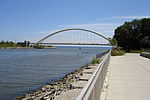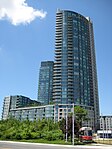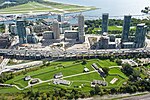Tip Top Tailors Building
1929 establishments in OntarioArt Deco architecture in CanadaBuildings and structures in TorontoIndustrial buildings completed in 1929

The Tip Top Tailors Building, now known as the 'Tip Top Lofts' is a former 1920s industrial building converted to condominium lofts in Toronto, Ontario, Canada. It is located on 637 Lake Shore Boulevard West just west of Bathurst Street, near the waterfront. It was the former headquarters of Tip Top Tailors Ltd., a Canadian menswear retailer.
Excerpt from the Wikipedia article Tip Top Tailors Building (License: CC BY-SA 3.0, Authors, Images).Tip Top Tailors Building
Lake Shore Boulevard West, Toronto
Geographical coordinates (GPS) Address External links Nearby Places Show on map
Geographical coordinates (GPS)
| Latitude | Longitude |
|---|---|
| N 43.635202 ° | E -79.402029 ° |
Address
Tip Top Lofts
Lake Shore Boulevard West 637
M5V 1B9 Toronto
Ontario, Canada
Open on Google Maps











